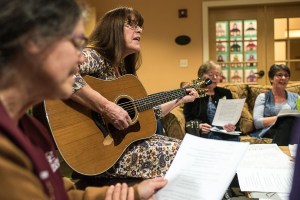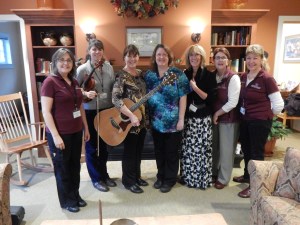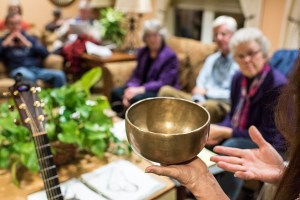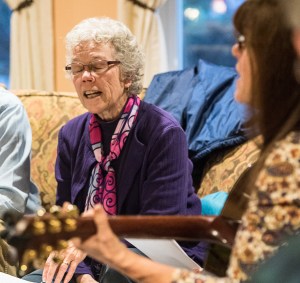Bedside singers bring therapy, comfort to those at the end of life
At Androscoggin Home Care and Hospice, music has long been a part of the program. The benefits of thoughtfully chosen music — some might say “music therapy” — to improve the quality of the end of life and to relieve pain and symptoms have been used by the organization since at least the late 1980s.
But over the last four years, the group has worked to make music an increasingly prominent part of its mission. As a growing movement of regular bedside singers takes root nationally and here in Maine, AHCH is looking to further expand its repertoire by conducting routine bedside musical visits.
“Music is a big thing,” says Karen Flynn, director of the Hospice Program at AHCH, president of the Maine Hospice Council and head of AHCH’s musical programs. Since opening Hospice House in Auburn in 2005, AHCH has “established a core of musicians,” says Flynn, who provide music for specific events, celebrations of life and intermittently to residents of Hospice House and other AHCH program users.
Even before music therapy came into its own as an integral and established part of medical healing, individual AHCH staff members were employing the therapeutic benefits of music. Flynn, who has been with the organization since 1988, says “personally I’ve always used music” as part of her patient outreach.
The use of music continued quietly when Hospice House opened. “This agency is really supportive of thinking outside the box,” says Flynn of AHCH.
Over the last four years, Flynn has led an effort to establish a choir — her “core of musicians” — that performs at organized events in central and western Maine and accompanies biennial Celebrations of Life, which are memorials to those AHCH program users and residents who have recently passed away.
The growing choir now has about 15 members who meet regularly. And while they have not started to formally conduct routine bedside singing, Flynn’s vision is to see the group “be a little more established and do (scheduled) bedside singing.” In fact, the musicians met recently in part to discuss formalizing their bedside performances. The group, says Flynn, is “really excited about” the prospect of bedside singing visits.
Harpist Melanie Lee is one of the musicians who plays with Flynn and additionally donates her time to perform solo at the bedsides of those in hospice and home care. Lee is a music practitioner, well versed in applying sound as a form of therapy.
“I usually start by setting my harp up in the hallway, to sort of set a tone,” she says. “Then the nurses will give me room assignments if patients want to have some live music. The music that I choose basically can depend a lot on what I feel they need.”
For example, says Lee, “if they’re agitated, calming music can help them. (For) patients that have irregular breathing, if I play something that’s more rhythmic, it can help their breathing pattern.”
As music practitioners and long-time students of music therapy, Lee and Flynn understand the science behind their service. But it is the reaction of patients and residents, and their families, that seems to most affect them.
“Music, live music in particular, really does impact people in a positive way,” says Lee. “The reaction is great, not just from patients but from patients’ families. It helps to relax them after a stressful day.”
Stirring memories, creating good vibrations
Kathy Amsden is an employee of AHCH and plays flute with the choir. “There’s a reason why I brought this flute,” she says at a recent meeting of the group. “It was given to me by my mom, and she passed away here at the Hospice House. And I used . . . it on the last night of her life to help her journey. The flute became quite important after that to help other people’s journeys.”
She adds, “I think for me, a meaningful moment is when I feel the urge to bring that flute and in some way it helps someone in their passing.”
As Flynn will tell you, growing evidence reveals just how beneficial music can be to healing or to providing comfort in the final stages of life.
“There’s a lot of research,” she says, but “the simple way of looking at it is this: The neurological system is really a vibrating entity. And the neurological system, it responds to changes in vibration. So sound is another way of tuning into someone’s vibration.”
“A resonant note is a pitch that’s hardwired into your nervous system,” says Flynn. “You might like some music over another. There’s a lot of research done (that suggests) that music and sound is actually food for the nervous system.”
Memory also plays a role, Flynn says.
“Where we sing and where music is stored and processed in the brain is its own special place . . . and it’s also where we store memories. So when you have people who are living with dementia, music and songs can actually reconnect that individual to a memory.”
For example, she says, “the violin is amazing (at connecting people with memories), or sometimes hearing a fiddle. And then lyrics themselves. Don’t we all have songs that we remember from seventh grade?”
“With hospice,” says Flynn, “part of what we try to do is really honor that person’s life. So life review is an enormous part of what we’re all doing.”
This means that the choice of music, whether for a large event or for a single hospice resident, is very important. “By design we select something that’s familiar,” says Flynn. “We generally stay away from religious songs, (as) it really isn’t denominational.”
When the choir performs, members often pick songs that include a lot of harmonies, as the acoustic effect can be powerful and stimulating for the listeners. Regardless of what they choose, they always try to tailor their performance to the needs and desires of the people they’re performing for, she says.
For their most recent performance — AHCH’s Celebration of Life — the musicians chose songs that reflected the emotional nature of the service. “We started with ‘Holy, Holy, Holy,’” says Flynn, “and there’s a lot of harmonies (there). It’s very rhythmic and relaxing.” They also employed a Tibetan singing bowl, which produces sounds deep, full and piercing. “The service is usually very moving and there’s a lot of emotion in the room,” Flynn says.
Long-time Vermont singers have Maine connection
As Flynn and company move to develop routine bedside performances, they will have a number of groups around the state to look to for guidance.
The Harbour Singers, a bedside choir based in Saco, since 2008 have been active in hospices, hospitals, nursing homes and private homes in southern Maine.
The Tourmaline Singers, also founded in 2008, are based in Waterville and serve that region. That group was started by Harry Vayo after he became music director of Waterville’s Unitarian-Universalist Church. The name is derived from Maine’s official gem and the ancient Roman legend that tourmaline possesses healing properties.
In nearby Vermont, the Hallowell Singers bring comfort to those in life’s final stages. They have been active in the Brattleboro area for more than a decade and are one of the country’s oldest bedside choirs. Their organizer, Kathy Leo, named the group in honor of a friend from Hallowell, Maine.
There are currently about 10 established bedside singing groups in Maine. In late October, Saco’s Harbour Singers hosted the first statewide conference on bedside singing, in Hallowell.
“The conference was something that I sort of wanted to do for the last two years,” says Ellie Rolnick, music director for the Harbour Singers, “to be able to connect to other people doing the same work we’re doing and also to introduce it to people who don’t know that this exists.”
Rolnick says the conference, which brought together nearly 90 people representing nine bedside singing groups in Maine and New Hampshire, was more successful than organizers had anticipated.
The Harbour Singers usually have around 30 members, says Rolnick, with about 20 members coming and going each year. Rolnick put the original group together seven years ago, when a choir member at her church wrote to her after seeing a video featuring the Hallowell Singers. “This was a brand new idea,” she says. “We had never heard of it before.”
“I would love to see this in southern Maine,” Rolnick recalls the letter saying, “and basically ‘Are you on board’? I wrote back saying, ‘Count me in.’”
Like Flynn and Lee, Rolnick sees the results of her efforts in the reception she gets from those in hospice, their families and the staffs of the facilities she serves.
“We are always welcome, (though) it’s different every time. If we go to sing to someone who is non-communicative, for instance, family members are very appreciative. And when we begin singing, often times (with) someone who is not very responsive, we’ll see their body move in time with the music.”
“We also sing for people who are very much awake and alert,” says Rolnick, “and they’ll sometimes sing with us. Sometimes people will cry when they’re sung to. But we’re always well received.”
Greeks, Egyptians employed benefits of music
While bedside singing for those at the end of life is a growing national and local movement, its roots go back to the very beginning of music.
The Greeks of antiquity worshipped Apollo, the god of both music and medicine. They also prayed to Asclepius, who cured the sick through music and song, and whose snake-entwined staff is the modern symbol of medical healing. We know that Egyptian temples were filled with music, intended to prevent illness. And around 400 B.C.E., the Greek physician Hippocrates was using music to treat mental illness.
Modern music therapy was advanced following the first and second world wars. Its study and development accelerated as a way to treat soldiers suffering from war-related trauma, both physical and mental. It was particularly employed in the United Kingdom, where groups of musicians began traveling to hospitals to play for the wounded.
The therapeutic services offered by bedside choirs today have been developing “for 40 or 50 years,” says Flynn. “Some of it, for us, is to reduce anxiety and pain levels. There’s lots of research about how music can bring down pain levels,” she says.
“I think some of it is enjoyable, relaxing. Most nursing homes will have some music programs going for the same reason,” adds Flynn. And “most hospices are starting to understand that music is a huge piece” when it comes to comfort at the end stages of life.
“Singing at bedside is a labor of love,” says Rolnick. “It’s not something that everyone is called to.” But Rolnick says that she and her choir members hope the movement is still growing. “More groups are needed,” she says.
Flynn shares a similar hope.
“Our dream is that by 2016, the singing that we’re doing” has moved from single events to more routine private experiences, she says. “Because the repertoire is building, we’d like to start at Hospice House. I think it’s where we’re going for 2016.”
And she’s positive about the burgeoning number of groups also conducting bedside singing around the state.
“These aren’t competitive groups. We all want to be of service. Right now there is no one doing this in the Lewiston area and we want to fill that need.”




Comments are no longer available on this story